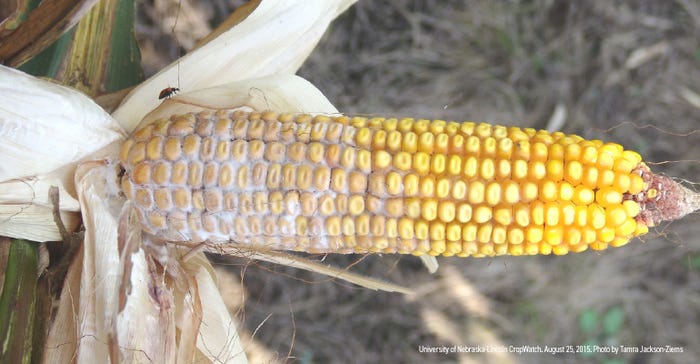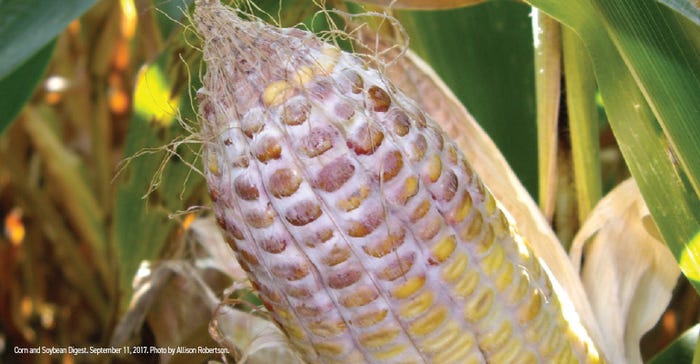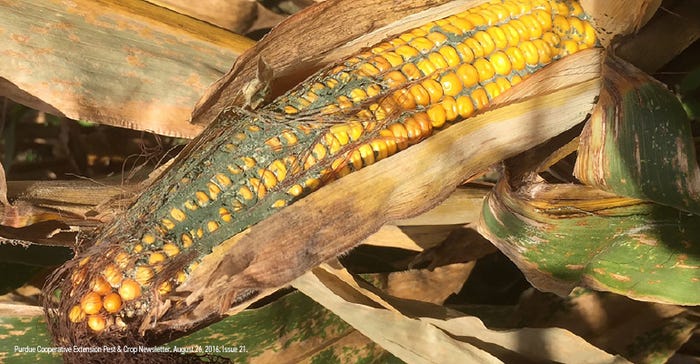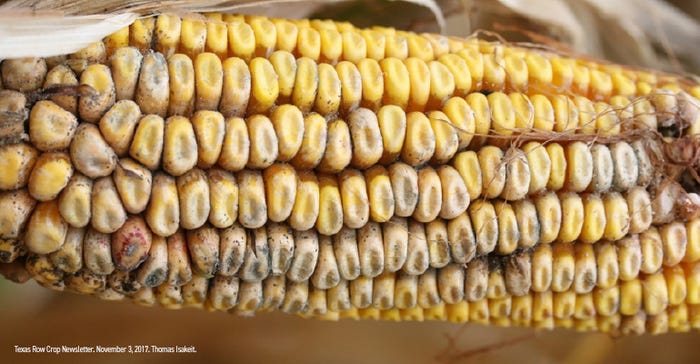October 1, 2020

Sponsored Content
Ear Molds can be an issue ever year to some degree. This can be due to husk coverage, rainfall/moisture after husks open up, or perhaps rotation. Scouting before harvest can help you determine if you have ear molds, and which ones you may have. This is very important for many reasons. First, if your corn is not dried properly, ear molds can grow inside your bin and damage more grain. Also, if you have ear molds that contain mycotoxins, you will need to isolate them in a separate bin to avoid contaminating your whole crop.
Why is this important? Many elevators will dock or even refuse to take corn that has been damaged by ear molds. We expect that ear molds will be big for harvest 2020, so make sure to keep an eye out for deteriorating grain quality. Here are some things to look for/keep in mind when identifying ear molds in your fields.
ASPERGILLUS:
Color: Gray-green, olive green
Identification: Powdery mold starting at tip of ear
Conducive Conditions: Common in dry/drought years. Damaged silks or kernels from insects or hail
Mycotoxin: Aflatoxin, toxic to livestock and humans
DIPLODIA:
Color: White to gray, severe infections can cause entire ear to be white or brown
Identification: Normally starts at the base of the ear and moves toward the tip. Grows in between kernels, speck sized black, fungal, fruiting bodies can form on the husk and kernels
Conducive Conditions: Residue left over from previous corn crop. Rain within two weeks of silking, insect and bird damage to ears. Conservation tillage and corn after corn
Mycotoxin: Not known to produce mycotoxins, but caution feeding to cattle and sheep
FUSARIUM:
Color: White to Pink
Identification: White streaks in kernel resembling a star-burst pattern, individual kernels scattered across the ear
Conducive Conditions: Hot, dry weather near flowering, damaged kernels from cracks and insects
Mycotoxin: Fumonisin, toxic to livestock
GIBBERELLA:
Color: Reddish to Pink
Identification: Often begins near the tip and grows down the ear.
Conducive Conditions: Infections favored by wet, cool weather right after silking. Corn after Corn or after wheat
Mycotoxin: Vomotoxin, can be toxic to humans and livestock, especially swine
PENICILLUM:
Color: Blue-Green
Identification: Powdery mold between kernels and starts at the ear tip
Conducive Conditions: Damaged kernels from insects, hail, frost
Mycotoxin: No known mycotoxins
TRICHODERMA:
Color: Dark Green
Identification: Grows on husk and between kernels
Conducive Conditions: Insect damage to kernels
Mycotoxin: No known mycotoxins

DIPLODIA

GIBBERELLA

TRICHODERMA

FUSARIUM
IF YOU HAVE EAR MOLDS, PROPER DRYING AND STORAGE IS EXTREMELY IMPORTANT.
Harvest, Storage and Handling
Ear molds can continue to progress in fields until temperatures drop below 40 degrees and kernel moisture drops below 15 percent. Corn that is intended to be stored for a long period of time should be dried to below 15 percent within 48 hours of being harvested. This will significantly reduce the chance of molds spreading while in storage. Since high moisture corn will head during storage and cause the toxins to spread, any high moisture shell corn used for feed should be kept away from corn that shows signs of ear molds.
Steps to Reduce the Spread of Ear Molds in Grain Bins:
Harvest corn early around 22 to 25 percent moisture
Adjust your combine to maximize cleaning, more fan speed can “blow” out damaged kernels
Corn should be dried to less than 15 percent moisture within 48 hours of harvest
Long term storage of grain should be dried to 13.5 percent moisture
Corn should be stored at 35 to 45 degrees F after drying
Check grain in bins often, stirring and aerating if needed.
Prevention Strategies for 2021:
Crop Rotation
Heavy tillage
Proper fertilization for the corn crop
Plant traited corn with above ground insect protection
Change hybrids in corn after corn fields 6. Plant a range of maturities of corn to spread out pollination
Be sure to scout your fields prior to harvest to determine if ear molds are present and which types. Be prepared to test corn that is intended for feed for the presence of mycotxins and understand the risk to both humans and animals.
Beck’s is the largest family-owned retail seed company in the United States that serves farmers in Illinois, Indiana, Iowa, Kentucky, Michigan, Minnesota, Missouri, Ohio, South Dakota, Tennessee, and Wisconsin. According to a recent seed industry survey, Beck’s ranks as the fourth largest corn and soybean brand in the United States. At their core, all Beck’s employees are Farmers at Heart. It stands for something special. It has soul. It has truth. And it represents a community of farmers, employees, and dealers who strive each day to seek challenges, push boundaries and innovate. Beck�’s has, and always will be, proud to serve a community of farmers who love what they do and who are proud to be… Farmers at Heart. For more agronomic new and information, visit Beck’s Agronomy Talk page or blog at BecksHybrids.com.
About the Author(s)
You May Also Like




